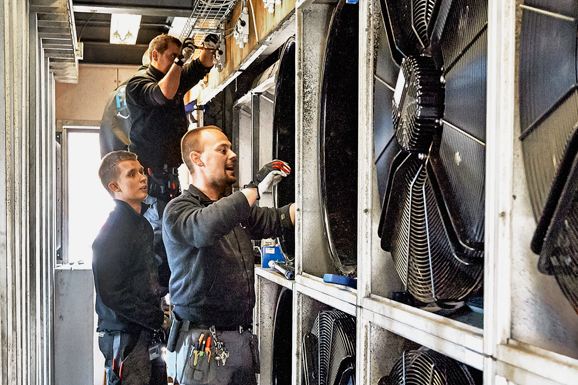The plight began six years ago with the installation of a new ventilation system. The noise that this system generated was conveyed through the ventilation ducts into all rooms of the psychiatry ward at the university hospital in the Danish city of Odense. It was noisy in the building, the installation company disappeared and simply refused to do anything about it.
Cheap fans cause headaches and tiredness

Jørgen Søfeldt, Function Manager at the University Clinic in Odense, is pleased with the silent fans.
Jørgen Søfeldt is a Function Manager at the clinic. He recalls: “The situation was so bad, we had to significantly curb the motor for the ventilation to make the noise level halfway tolerable.” Torben Lintrup Kirkholt, Managing Director of ebm-papst Denmark, describes the situation: “There was still an audible rumbling throughout the building, like a clothes dryer full of tennis balls.” That was bad for the patients, who are often particularly sensitive to noise. But there was worse to come.
“The ventilation system was only running at 60 percent capacity. That meant that the air exchange rate and the air flow needed for a healthy interior climate were nowhere near achieved”, reports Kirkholt. “Therefore it was too hot in the building, the CO2 concentration in the air was much too high and it was so humid that mould formed in the corners, all the ingredients for sick building syndrome.”
“The system was making a noise like a clothes dryer full of tennis balls.”
Torben Lintrup Kirkholt, Managing Director of ebm-papst Denmark
The humid room climate and the mould threatened the health of both doctors and patients. Ambient air with a high CO2 content also leads to tiredness, loss of concentration, headaches and dizziness. Opening the windows for some fresh air was not an option for the psychiatric ward, as they could not be opened for safety reasons. Stuffy, humid and loud – not the ideal environment for patients who should be able to rest in peace and quiet.
The solution came as a bit of a coincidence. Søfeldt reports: “In other parts of the university hospital building like the kitchen and laundry, we had had energy-saving fans installed by ebm-papst. When I described our noise problems in the psychiatric ward in passing to the ebm-papst staff, they said they might be able to help.” ebm-papst replaced one of the old fans as a trial.
Kirkholt explains: “They were only about six years old, but used 1980’s technology: a poor AC electric motor with a cheap frequency inverter and an impeller made from low-grade sheet metal. These three things together caused the noise problems. You could tell right away that the company that had installed these were only interested in fitting the cheapest devices possible.” Everything was fine with the RadiPac EC centrifugal fan which was installed. Søfeldt was surprised: “We had no idea that it was just the old fans that were causing the noise!”
Better climate, lower costs
The decision was an easy one: all twenty of the old fans had to be removed and replaced by the EC centrifugal fans. ebm-papst completed the job in a week. The system now runs at full capacity and the climate in the room is perfect. And importantly, no noise. The icing on the cake is the amount of energy saved. Thanks to the EC fans, the psychiatric clinic now saves around 5,650 euros on its annual electricity bill. The fans will have paid for themselves in just seven years.


Leave a comment